Reports
Revisiting Kangsong: A Suspect Uranium Enrichment Plant
by David Albright, with assistance from Sarah Burkhard
October 2, 2018
In May 2018, I decided to reveal publicly the assessment that North Korea may have a secret uranium enrichment site called Kangsong. I did so in a slide presentation titled “On the Question of Another North Korean Centrifuge Plant and the Suspect Kangsong Plant.” I had been discussing this facility with officials from governments for several months and decided that public revelation of the site would increase transparency about the existence of Pyongyang’s undeclared nuclear facilities. I hoped it would help ensure a more thorough, public discussion of steps needed to achieve verified denuclearization in North Korea. After all, these same officials with whom I had been discussing the site had stated that over half of North Korea’s nuclear sites known to intelligence agencies are outside Yongbyon.
In the presentation, I noted that there were significant uncertainties over whether Kangsong was in fact an enrichment plant. North Korea denies having any enrichment plant outside of the Yongbyon nuclear center, and centrifuge plants are notoriously difficult to spot using remote tools. Absent North Korean declarations and U.S. or International Atomic Energy Agency (IAEA) inspections of the site, any public debate about undeclared nuclear sites is fraught with uncertainty. Kangsong is no exception.
The Kangsong case is a microcosm of the challenges of verifiably dismantling North Korea’s nuclear weapons program. How do we learn where all of Pyongyang’s nuclear facilities and weapons are located using only national technical means? While there is high confidence in the knowledge of North Korea’s currently rather limited, but potentially growing, plutonium production and separation capabilities, all of which are believed to be at Yongbyon, there is widescale uncertainty about North Korea’s uranium enrichment capabilities. Most estimates of the number of North Korean nuclear weapons are increasingly dominated by predicted stocks of weapon-grade uranium produced in an enrichment program that is poorly understood. The value of agreements limited to the Yongbyon nuclear site are thus undermined by the existence of potential places like Kangsong that could make weapon-grade uranium, combined with the paucity of information about the size or location of North Korea’s nuclear weapons arsenal in general. There is little value in spending negotiating capital to achieve denuclearization only at Yongbyon, when North Korea would keep secret sites able to continue producing weapon-grade uranium that would allow it to enlarge its nuclear arsenal, perhaps significantly.
Concentrating on first freezing or dismantling nuclear facilities at Yongbyon will not address the fundamental problem of whether it is possible to achieve a worthwhile, verifiable denuclearization agreement. This fundamental issue needs to be answered first via North Korean steps that show it is committed to adequate declarations and verification, and the elimination of its nuclear weapons, even though this process may take several years. The declaration should allow a comprehensive, consistent picture of all fuel cycle activities.
Recent offers by North Korea to dismantle the nuclear facilities at Yongbyon as a step toward denuclearization, while also refusing to reveal its nuclear capabilities, in particular enrichment capabilities, elsewhere, should not be given much value. If North Korea provides an adequate declaration and allows outside inspections of its facilities, then the offer to verifiably dismantle Yongbyon could be a meaningful first step in the process of verifiably denuclearizing the country.
Otherwise, the United States risks that the impact of sanctions, and its key leverage, will diminish long before a denuclearization outcome is achieved. Moreover, a piecemeal strategy, like earlier ones, increases the risk that the denuclearization process will fall victim to on-going tensions or North Korean recalcitrance over disarming, particularly when future denuclearization steps require it open up its country and military sites to inspectors. In that sense, time is not on the side of the United States, and a priority must be learning about all of North Korea’s nuclear capabilities, materials, and activities and sculpting a verified dismantlement plan as soon as possible.
Rationale for Release
By releasing information about Kangsong, despite governmental resistance to doing so, I wanted to ensure greater transparency and reduce the chance that someone would leak the information to the media, omitting uncertainties that I know have been debated behind the scenes by government experts. Too often, selective nuclear-related leaking serves to distort the public debate, and the media often does a poor job of not being used by the leaker. It turned out that this concern was justified.
I decided to proceed without revealing, or even knowing, the exact location of the site, preferring instead to characterize the uncertainties and discussions among states scrutinizing the site. In this way, publics could look deeper into the analytical world of making sense of North Korea’s hidden nuclear capabilities.
Most agree that the Yongbyon gas centrifuge plant is unlikely the only one, wherever the other one(s) may be. A common view, which will be discussed below, is that North Korea has as much or more enrichment capacity located outside of the Yongbyon nuclear site than inside it. This result means that if the Yongbyon site is shut down and other enrichment plant(s) continue operating, North Korea could make enough weapon-grade uranium at other sites for several nuclear weapons per year – hardly a desirable outcome. Thus, the public release about the Kangsong plant also focuses attention on other parts of North Korea’s nuclear weapons production complex that should not be downplayed or ignored in a denuclearization process.
Follow-Up to Decision to Release
The Washington Post covered the Institute’s public release of the Kangsong information.1 The specific coverage in the article about Kangsong was fair, and the reporters were able to confirm my findings, although the U.S. intelligence community would not comment. A few weeks later, The Washington Post published a hyped-up, inaccurate story that misreported the Kangsong enrichment site as located underground, omitted all the uncertainties held by intelligence agencies, and dropped the “g” from its name, calling it the Kangson site.2 (In spelling the names of North Korean locations in English, differences in transliterations are common; our sources stick with the “g” at the end).3 However, the errors and tone of the report pointed to an effort to quote Defense Intelligence Agency (DIA) reports, with the effect of exaggerating the situation. Although DIA does excellent work, it is well known to be one of the most forward-leaning of the intelligence agencies on North Korean nuclear assessments. In this case, The Washington Post did the public a disservice.
One beneficiary of the alternative spelling was Jeffrey Lewis and his colleagues at the Center for Nonproliferation Studies of the Middlebury Institute of International Studies, who located a suspect site near the town of Chollima, not far from Pyongyang, based on the name of Kangson, as covered in a July 2018 report by The Diplomat. We certainly commend this group for discovering a credible suspect building, although they seem to overrate their skill in characterizing the building as a centrifuge plant and should have cited my original work on Kangsong instead of the second, inaccurate Washington Post report. Lewis et al. noticed that the Japanese in World War II had used “Kangson” to refer to Chollima. He and his colleagues then located a relatively large building with security surrounding it.4 Other than finding a large, secure building and depending on my identification of the name of the suspect site, the article covering the find principally relies on an anonymous “U.S. government source with knowledge of the latest intelligence on North Korea” to call it an enrichment plant. In fact, the article makes the rather bold assertion: “The facility is North Korea’s first covert uranium enrichment facility, known by the U.S. intelligence community as the Kangson enrichment site.”5 However, it also quotes Lewis, to his credit: “What we feel comfortable saying is that we can’t say whether it is, or is not, an enrichment plant.” Given that all discussion of uncertainties about the site are dropped in this media report, one has to ask if this article’s source is repeating inflated intelligence agency information. The article also repeats a highly controversial DIA claim that North Korea’s fissile material stockpile was sufficient in 2017 for at least 60 weapons and growing at a rate of 12 per year.
In August 2018, the IAEA reported that it had “evaluated all safeguards relevant information, including satellite imagery and open source information, about a group of buildings within a security perimeter in the vicinity of Pyongyang. The size of the main building and the characteristics of the associated infrastructure are not inconsistent with a centrifuge enrichment facility. The timeline of construction is not inconsistent with the reported uranium enrichment” program of North Korea.6 This location appears to be the same one identified by Lewis et al. However, the IAEA added that, without access, it cannot confirm the nature and purpose of the activities conducted therein. The use of the odd phrase “not inconsistent,” an obviously incorrect grammatical construction, has typically meant in IAEA parlance that the statement did not have any detectable inconsistencies, but the assertion may still not be true or the complete truth. It was overall a weak endorsement of the idea that the site identified was that of a secret enrichment plant.
Characteristics of the Suspect Site
With a credible candidate site for the Kangsong enrichment site, it makes sense to delve more deeply into analyzing the building and adding to the available public information about this suspect enrichment site. Ultimately, it will likely take visits by inspectors to sort out the truth, hopefully aided by a North Korean declaration.
As I originally reported, the first information about the Kangsong site came from a defector, who revealed the existence of it several years ago to South Korea. The defector said that he worked nearby and told the South Korean government where the purported enrichment plant was. According to intelligence sources, the site had been active for many years. It is significant that this person did not state he or she worked at the site. It is my understanding that South Korea did not make a judgement about the site, instead treating it as unconfirmed information.
As is standard practice, South Korea conveyed this new information to allied governments without a determination about its veracity by about 2016. This led to several governments starting their own analysis of the site.
It is unclear if the defector revealed any concrete information specifically about the inside of the Kangsong plant, in particular the type of centrifuges or its operational history or status. The United States may possess such information, and appears to be the strongest supporter of the determination that the Kangsong site, wherever it may be, is an enrichment plant. What is clear, however, is that for several years the United States has believed that at least one other centrifuge plant has existed, and that the Kangsong facility is viewed as an enrichment site. But is it?
Background on Procurements. Before looking specifically at the identified site, it makes sense to first review some of what is known about North Korea’s enrichment program. It uses gas centrifuges that have a European origin and whose designs were stolen by A.Q. Khan and Pakistan from URENCO. North Korea received a starter kit from Pakistan in the 1990s that included a few tens of centrifuges and considerable knowledge and design information about making and operating them. A great deal of information about Pakistan’s centrifuge program and its assistance to North Korea was learned in the prosecutions of Khan’s associates around the world and from his confession to his government about his illicit dealings and peddling of centrifuges to Iran, Libya, North Korea, and possibly others.7
Procurement information collected by governments provides another source of data about North Korea’s centrifuge program. Western countries track North Korea’s procurements for its centrifuge program closely, which until recently, was aided by North Korea often not disguising the North Korean purchasing entity. As a result, specific procurements could be tied to the centrifuge program. Moreover, these procurements involved equipment, components, and materials known to have been acquired by Pakistan for its P2 gas centrifuge plants. In sum, the available information allowed a relatively close tracking of North Korea’s procurements for its centrifuge program, in terms of specific items, but also quantities.
That North Korea uses P2 centrifuges was confirmed on a visit by U.S. experts to the Yongbyon centrifuge plant in 2010. This visit served to provide an important baseline on North Korea’s gas centrifuge program. During interviews I conducted in Pyongyang in 2011 with North Korean nuclear officials, I was able to establish that the Yongbyon centrifuge plant used a cascade design at Yongbyon that was of a Pakistani design. Cascades are groups of centrifuges connected with piping and operate under vacuum. Knowing details about the centrifuges and their layout in a facility allows a more accurate tracking of the program’s procurements, particularly since North Korea appears to have essentially duplicated Pakistani centrifuge plant designs, down to the lighting in some cases.
When the procurement data are assessed collectively, governments have detected what they believe are several peaks in procurements for North Korea’s centrifuge program. These peaks suggest a concerted effort to acquire the wherewithal to build a centrifuge plant at that point in time. Peaks have been observed in:
- 2002/2003: procurements sufficient for about 8,000-12,000 P2-type centrifuges, e.g. Optronix case and 8000 aluminum casings from Russian company Norilsk Nickel;
- Between 2003 and 2008: many procurements for centrifuge program but the number of centrifuges unclear but possibly enough for several thousand more;
- Around 2008: procurements sufficient for 2,000 P2 centrifuges;
- End 2010: procurements sufficient for 500-1000 centrifuges;
- Early 2016: procurements detected sufficient for one low enriched uranium (LEU) cascade
It should be noted that procurements can be missed. As a result, these numbers would tend to err on being underestimates rather than overestimates.
One interpretation of these peaks is that they correspond to the building or expansion of a centrifuge plant. Starting with the last ones, the 2008 peak likely corresponds to the building of the Yongbyon centrifuge plant, which at the time of the 2010 and 2011 visits by U.S. experts, had 2,064 P2 centrifuges organized into six cascades. The plant’s subsequent doubling in floor space correlates with the procurement peak in 2010. The earlier peak in 2002/2003 and the peaks in the subsequent several years suggest the construction of another, earlier production-scale centrifuge plant, perhaps two plants. At least one such plant would be expected. Perhaps only one was built in this timeframe of the early to mid-2000s and thousands of centrifuges broke during operation, which was not uncommon in Pakistan’s and Iran’s centrifuge programs.
Suspect Complex. How does Kangsong, in particular the site identified by Lewis et al., fit into this picture? The simplest interpretation is that Kangsong is North Korea’s first production-scale centrifuge plant built by about 2005. It was designed to hold 6,000-12,000 P2 centrifuges. Publicly available satellite imagery from May 2001 shows empty fields where the building exists today (see figure 1).8 The site is south of Pyongyang, and roughly three kilometers east of a major ballistic missile factory, which is consistent with the information I received.9 Construction at the suspect site started soon after the May 2001 image; an April 2002 image of the site under construction, which was obtained by Middlebury Institute of International Studies’ Geo4Nonpro project, shows erect buildings in the housing and support area and the early stages of what would become the main building.10 The construction timeline is therefore roughly consistent with the earliest procurement peak.
Figure 1. The location of the suspect site in May 2001 before construction started shortly after.
The site appears to have three security regions. One surrounds the building itself, another contains a residential zone next to the plant and some industrial or office buildings, and the third is the outermost security perimeter, enclosing both of the inner ones (see figure 2). A narrow access passage, likely controlled by a security checkpoint, connects the housing area to the plant. It is reasonable to assume that the workers, including technicians and engineers, live in a secure, closed environment. One would assume that, with a project as sensitive as a secret enrichment plant, the workers would be closely monitored and would not be allowed to leave the site without permission. After all, for years, North Korea vehemently denied having a centrifuge program. The site is consistent with a requirement to carefully control the people working at the site.

Figure 2. The site appears to have physical security measures consistent with being a secret enrichment plant in an image from March 2009.
The building itself has dimensions of 110 m by 50 m, resulting in an area of 5,500 meters squared. This floor area is not consistent with a one-story plant holding up to 12,000 P2 centrifuges. Some in the intelligence community assert that the plant has this number of centrifuges. This leads to the first anomaly at this site. The internal structure of this building is not known. However, for simplicity, one can start by assuming one floor dedicated to cascades to make low enriched uranium; this gives the maximum density of centrifuges in a Pakistani-style centrifuge plant. Using information about the Yongbyon centrifuge plant and other Pakistani-style centrifuge plant layouts seized in Khan prosecutions, this plant would be expected to hold approximately 5,500 to 6,300 P2 centrifuges, based on a study the Institute did earlier in 2018 when it analyzed Pakistani-style cascade halls.11 If the plant was designed to make weapon-grade uranium using the four-step Pakistani plant design, this area would hold many fewer centrifuges.12 It should be noted that if this facility is designed to make only low enriched uranium, there is likely another facility to take this product and further enrich it to weapon-grade.
Another anomaly, according to government sources, is that the main centrifuge plant is taller than typical centrifuge plants. This statement is more difficult to understand in the context of the building identified in The Diplomat. It appears taller than other ones, although not in all cases. Nonetheless, commercial satellite imagery shows two rows of windows, suggesting that the main hall has at least two floors (see figures 3 and 4). Such a structure is not typical for a Pakistan-type centrifuge plant.
Figure 3. The short back side of the building is visible in a September 2015 image due to the angle at which the satellite photo was taken.
Figure 4. The windows at the long back side of the building also indicate a structure with at least two stories, in an image from December 2017.
In the inter-governmental deliberations, a key topic has been whether the plant is actually comprised of two floors of centrifuges. One Western government investigated the building’s height and structure, assessing that it is tall enough to hold two floors of P2 centrifuges. If this is the case, then it could hold, in theory, up to 12,000 P2 centrifuges.
However, constructing a first plant with two floors filled with centrifuges would be difficult to understand. There is no real reason to build a second floor when another or larger building could be used. North Korea has larger buildings nearby, for example at the nearby Tae-sung Machine Factory, so their size does not point to a centrifuge effort. Moreover, according to experts in these types of centrifuges, a country building its first centrifuge plant would be severely challenged in building two floors of centrifuges. Thus, an alternative assessment is that a facility built in the 2000-2005 timeframe would have only one floor of centrifuges and be limited to less than 6,000 P2 centrifuges.
Some government experts raised the possibility that Kangsong is North Korea’s second production-scale enrichment plant, and that there is an earlier one at an unknown location. This earlier plant would have only one floor of centrifuges. Kangsong would be the second one, built after about 2005 with a more sophisticated two-story structure. However, the visible construction activity at the identified Kangsong site in 2002 argues against this possibility.
Another possibility is that Kangsong was originally built for some other reason and re-purposed later into a centrifuge plant. Earlier, some thought this site was related to missile production and possibly associated with the nearby missile manufacturing site. 38North raised this possibility recently and speculated that it is still the case.13 Moreover, the Yongbyon centrifuge plant was built in an old building originally used to make fuel for the 5 megawatt-electric reactor. If this were the case with Kangsong, the anomalies of the building’s height would not matter, as it could have just one floor of centrifuges.
Lewis and The Diplomat pointed to heat generation (namely melted snow on the roof of the main building) as supporting their claim. However, they were correct to caveat that this only added support to the building having a significant military-industrial role in a nation starved for energy. As important as heat in the winter is air conditioning in the summer to operating delicate centrifuges. The cascade area of a building running P2 centrifuges should be held at a constant temperature as part of ensuring that the centrifuges will work as designed. Some designs use water cooling piping around each centrifuge to control the centrifuge temperature, but not the P2. One would expect, as a result, that the building would have cooling units, since North Korean summers can be quite hot, well above the roughly 20 degrees centigrade often found in a similar centrifuge plant. The Yongbyon plant has such units (see figure 5). We have not located these units at the suspect site or learned how this plant is cooled in the summer. There may be some cooling towers located about 100 meters from the building on the edge of the site, but these appear more related to heat dissipation from a nearby building, whose purpose could not be determined. Figure 6 shows these apparent cooling towers. However, we cannot exclude that we have not found the piping connecting these cooling towers to an air conditioning system for the main building.
Figure 5. The cooling units help control the temperature inside the centrifuge halls at Yongbyon.
Figure 6. Potential cooling towers can be observed at the suspect Kangsong site, however, their distance from the main building seems rather large. Moreover, evidence of piping could not be found linking these cooling towers with the main building, which is about 100 meters away.
There are some additional anomalies that raise questions about the site’s purpose. One is the relatively high frequency of truck traffic around the building that can be seen in commercial satellite imagery (see figure 7). A centrifuge plant this size does not have that many deliveries when it is being operated successfully. For example, it would receive spare parts and cylinders of natural uranium and ship enriched uranium cylinders that would require truck transport, but not as frequently as the visible truck traffic suggests. Moreover, at the Yongbyon centrifuge plant, there is no corresponding level of truck traffic visible in commercial satellite imagery, even accounting for plant size differences.
Figure 7. In satellite images taken over several years, consistent truck traffic can be observed at the suspect site. Trucks often appear parked in the entrance area of the site, and also at the back sides of the main building.
During construction, one would expect there to be many truck deliveries. For example, the building does not appear to have facilities to make gas centrifuge components, and manufacturing appears to be done elsewhere. Thus, there would be many deliveries of P2 centrifuge rotor assemblies, piping, and other equipment necessary to outfit and operate a centrifuge plant (see figure 8). However, major truck traffic is still observed after the projected construction period, which is estimated as having occurred in the 2000s. Consistently over the years from 2009 to 2017, where satellite imagery is publicly available on Google Earth, shipping containers, and large and small trucks can be observed around the main building. Large trucks are often stationed at the long back side of the building, and small trucks at the short back side, presumably to unload goods.
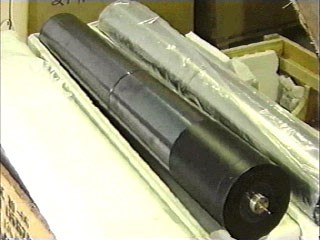
Figure 8. P2 centrifuge rotor assembly in a packing crate.
Another explanation for the frequent presence of trucks could be that the plant failed and had to be rebuilt over the time period of 2009 to 2017, requiring regular deliveries of large numbers of centrifuges and associated equipment, such as piping. Commercial satellite imagery does not show trucks being unloaded, although metal objects and wooden boxes have been seen by governments, which have higher quality and resolution imagery. However, this characterization would conflict with the Yongbyon centrifuge plant being built in 18 months during the start of this time period, with few visible signatures.
Another, less divisive anomaly some have brought up is that visible power transmission to the site may be inadequate for such a large centrifuge plant. However, there could be underground power lines.
All of these anomalies can be explained in the context of the suspect location still in fact being the Kangsong enrichment plant. But they should create caution and motivate further effort to understand this site, including maintaining the possibility that this site may not be a centrifuge plant. One government expressed this view, stating that the building is not consistent with a centrifuge plant. Defectors have also been notoriously unreliable. On that, I would have to agree. One government gave me four names of North Korean centrifuge plants a few years ago, none of which was Kangsong, and all were stated to be places where defectors said there was a centrifuge or enrichment plant.
Other Capabilities at the Site
If the identified facility is a centrifuge plant, the site should have an associated facility to do the final assembly of centrifuge rotor assemblies. Based on looking at the available images, there appears to be a range of buildings in which rotor assembly could be done. Such a facility does not need to be large. According to a defector who worked on centrifuge assembly at Yongbyon, the Yongbyon facility has only a small centrifuge assembly hall, operated under clean room conditions, where pre-assembled parts are delivered and assembled into final components. He stated that he was involved in the initial centrifuge assembly of the Yongbyon plant and had no prior experience assembling centrifuges.
There is also a new building at the site, near the residential area. It could be for metal recovery (see figure 9).
Figure 9. A Google Earth image from September 2015 shows a building under construction.
Conclusion
The identified building may be a gas centrifuge plant with up to 6,000-12,000 P2 centrifuges. However, it seems premature to treat this site as a definitive production-scale enrichment plant, despite it being a reasonable candidate. Efforts to ignore uncertainties by quoting categorical claims by unnamed intelligence sources should be resisted. Identifying and characterizing uranium enrichment plants in North Korea is an extremely difficult intelligence challenge, and there are notable disagreements among intelligence agencies. Focusing on only one side of this debate is not in the public service.
Nonetheless, the existence of secret enrichment plants in North Korea seems credible. It is important to confirm whether Kangsong is a production-scale centrifuge plant and to learn if any others exist. It is incumbent on North Korea, if it is serious about denuclearization, to reveal its entire enrichment program and allow adequate verification, including detailed declarations and on-site inspections and the taking of samples. Unless North Korea declares its entire centrifuge complex, and allows adequate verification of its declaration, any denuclearization agreement will likely be worthless and lead to endless speculation about where its critical nuclear assets are located.
1. Joby Warrick and Soaud Mekhennet, “Summit collapse foils chance to press North Korea on suspicious sites,” The Washington Post, May 25, 2018. https://www.washingtonpost.com/world/national-security/summit-collapse-foils-chance-to-press-north-korea-on-suspicious-sites/2018/05/25/d5a14044-602d-11e8-9ee3-49d6d4814c4c_story.html?utm_term=.a86eb44a2bf1 ↩
2. Ellen Nakashima and Joby Warrick “North Korea working to conceal key aspects of its nuclear program, U.S. officials say,” The Washington Post, June 30, 2018. https://www.washingtonpost.com/world/national-security/north-korea-working-to-conceal-key-aspects-of-its-nuclear-program-us-officials-say/2018/06/30/deba64fa-7c82-11e8-93cc-6d3beccdd7a3_story.html?utm_term=.1ecfd8c2db01 ↩
3. One source now refers to the plant as Kangson(g). ↩
4. Ankit Panda, “Exclusive: Revealing Kangson, North Korea’s First Covert Uranium Enrichment Site,” The Diplomat, July 13, 2018. https://thediplomat.com/2018/07/exclusive-revealing-kangson-north-koreas-first-covert-uranium-enrichment-site/ ↩
5. Ibid. ↩
6. IAEA Director General, Application of Safeguards in the Democratic People’s Republic of Korea, GOV/2018/34-GC(62)/12, August 20, 2018. http://isis-online.org/uploads/iaea-reports/documents/DPRK_safeguards_report_IAEA_20Aug2018.pdf ↩
7. Albright, Peddling Peril: How the Secret Nuclear Trade Arms America’s Enemies (New York: Free Press, 2010); and http://isis-online.org/peddlingperil ↩
8. The lower bound assumes significant centrifuge breakage. ↩
9. The missile factory nearby is called the Tae-sung Machine Factory. (This site also has large secure buildings but few would call them centrifuge buildings.) See Joseph S. Bermudez Jr, “The Tae-sung Machine Factory,” KPA Journal, Vol. 2, No. 5, May 2011, http://www.kpajournal.com/vol-2-no-5-may-2011/ ↩
11. David Albright, Sarah Burkhard, and Frank Pabian, Pakistan’s Growing Uranium Enrichment Program, Institute for Science and International Security, May 30, 2018. http://isis-online.org/uploads/isis-reports/documents/Kahuta_Update_30May2018_Final_with_time-lapse.pdf ↩
12. For a description of the four-step process, see Pakistan’s Growing Uranium Enrichment Program, ↩
13. Michael Madden, “Much Ado About Kangson, 38North, August 3, 2018. https://www.38north.org/2018/08/mmadden080318/ ↩

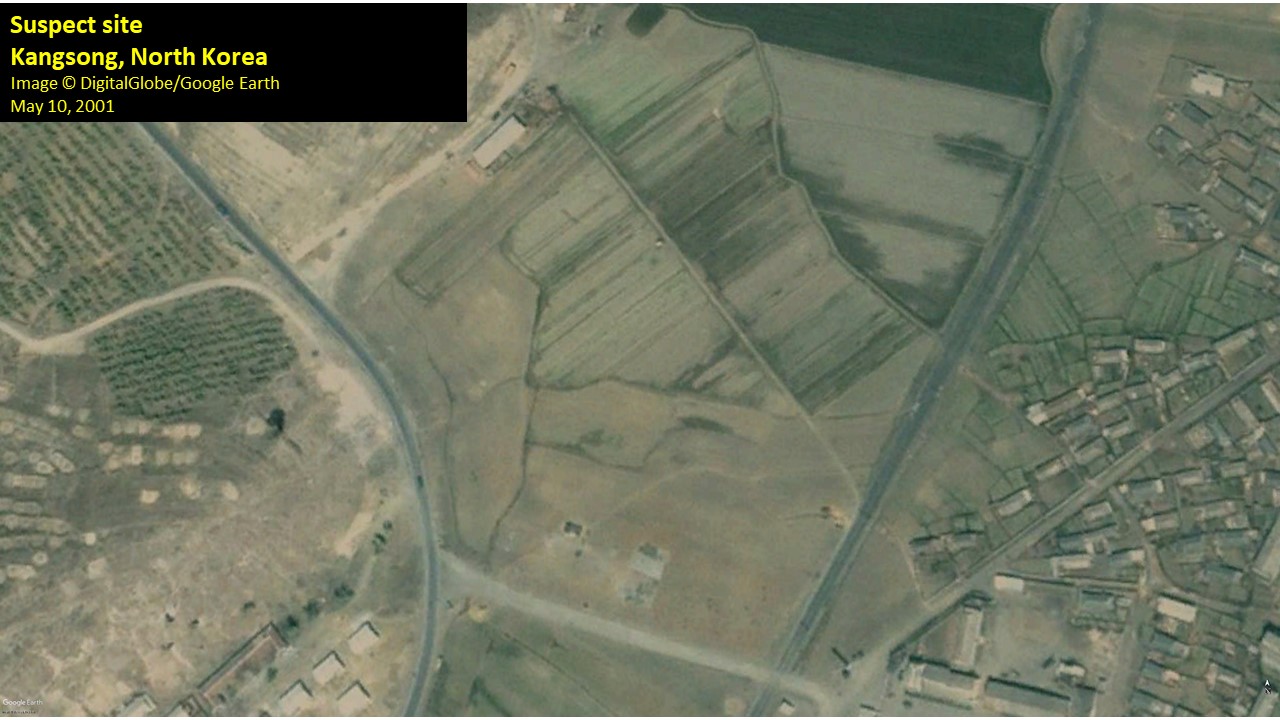
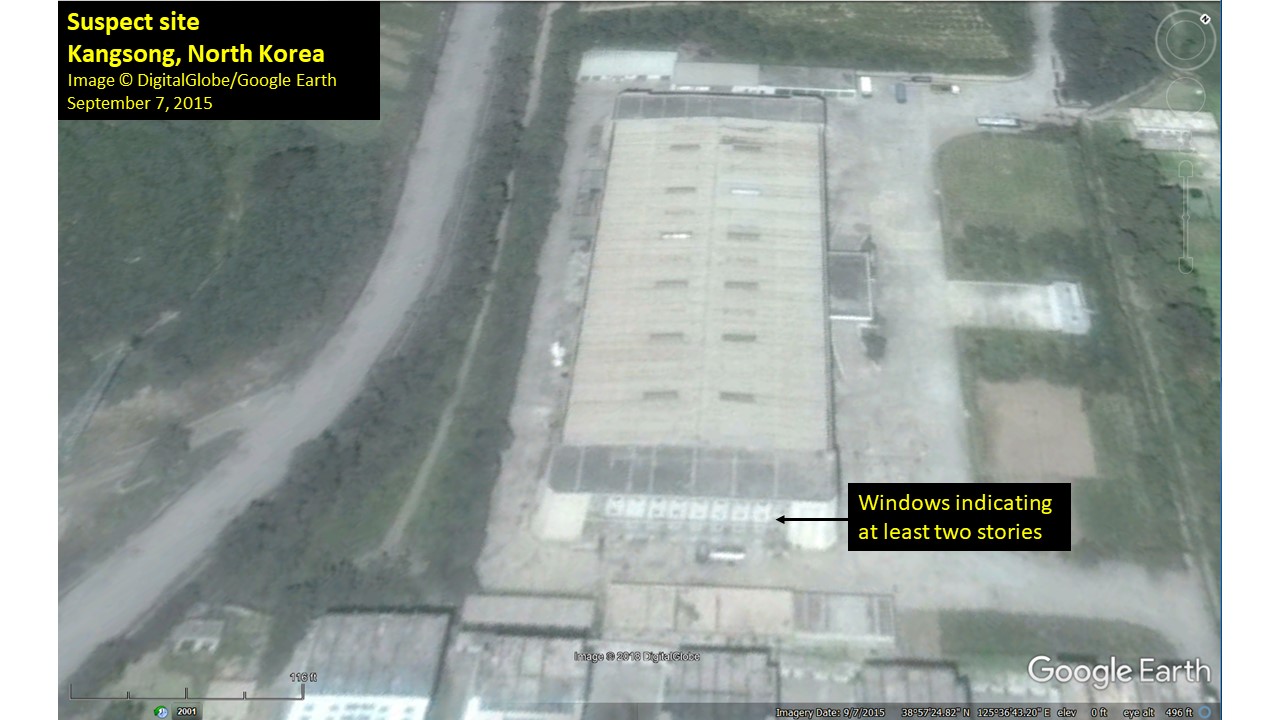
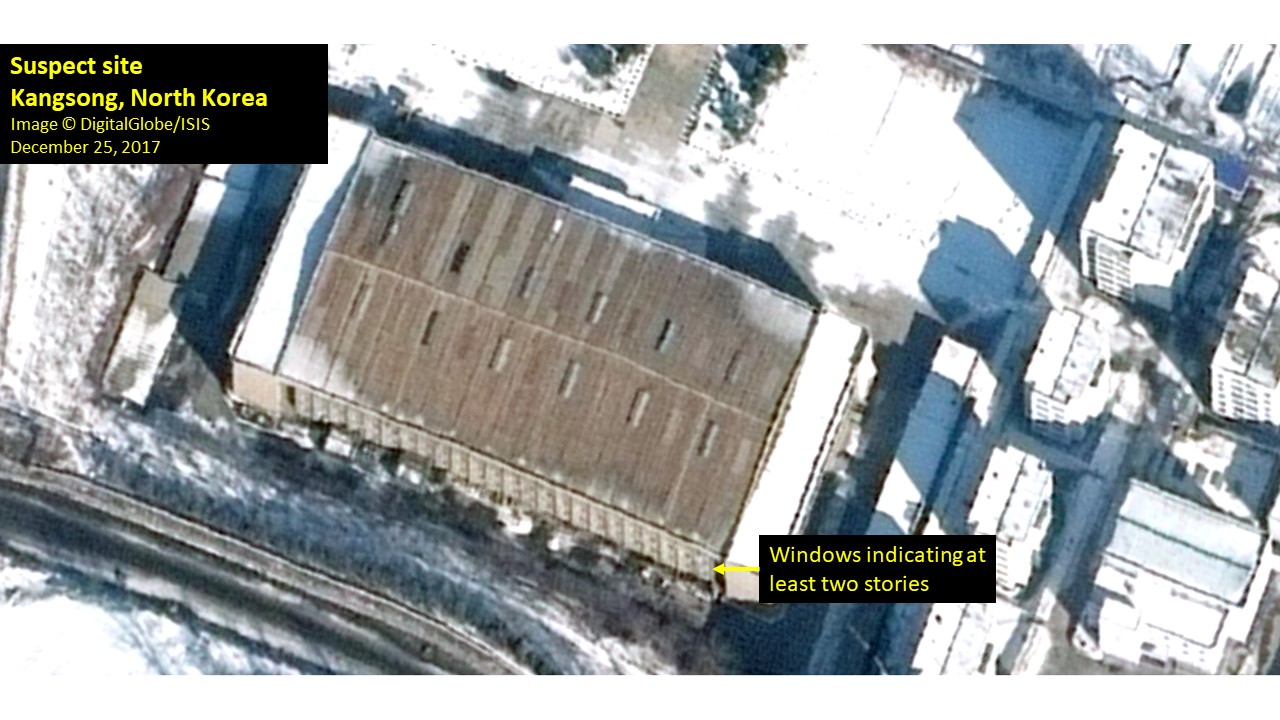


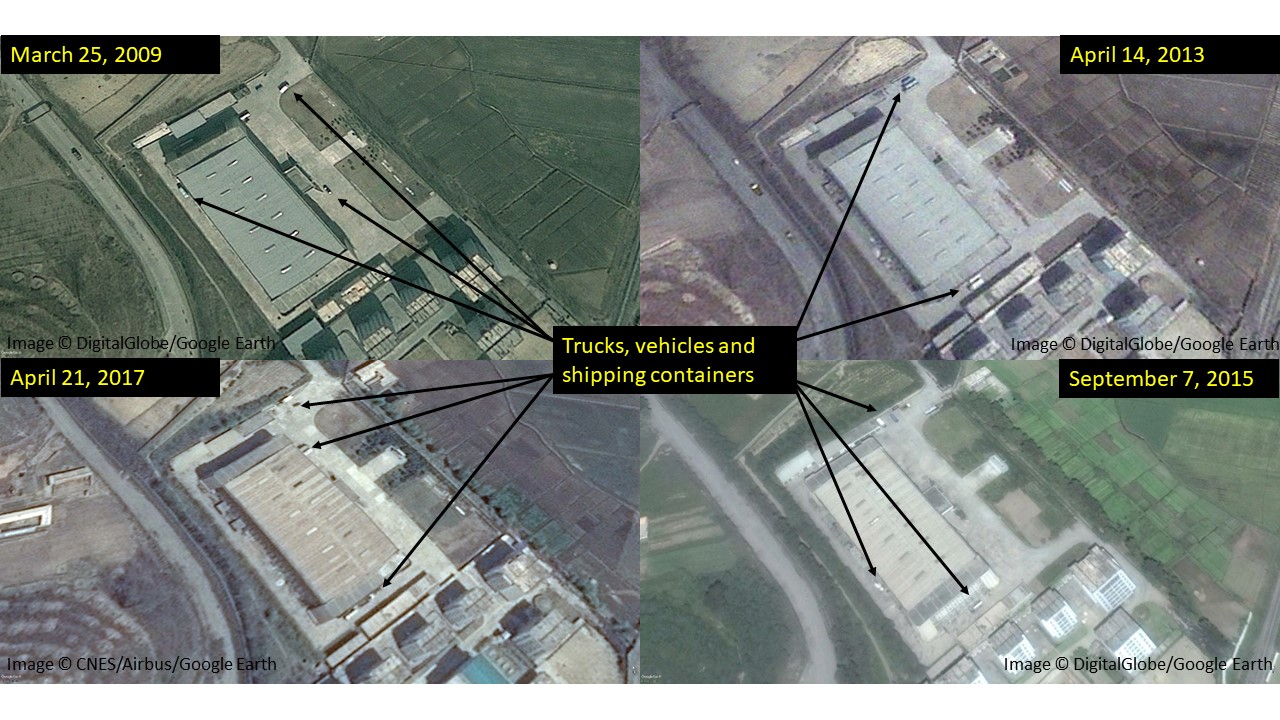

 twitter
twitter